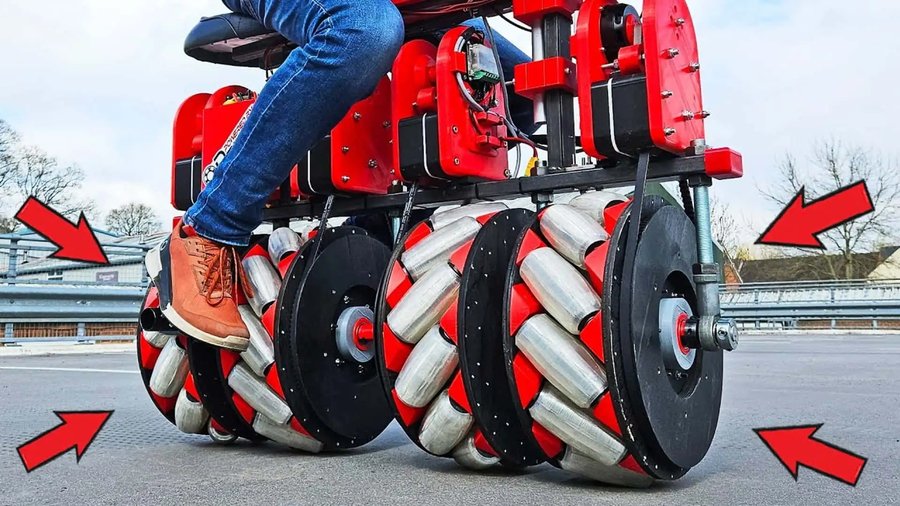Watch This Guy Build The World's First Screw Bike With Wild 3D-Printed Wheels

What do you get when you have a mechanical engineer, inventor, roboticist, and general multi-hat-wearing DIY-er in a single person, and that person also has a YouTube channel? There might be more than one answer here, but in our particular case, you get a guy by the name of James Bruton.
Over the time he's been making and posting videos to YouTube, he's tackled any number of projects. From recent ones like a walking Star Wars droid to an ongoing series of balancing robots, part of Bruton's magic as a video creator is in a) his building demonstrations and b) his explanations of how and why he's doing what he's doing.
Like any good creative, it's also clear that he learns and iterates future projects based on what he's figured out with previous ones. While it's clear that he's super knowledgeable, what that solid base of knowledge seems to do is allow him the freedom to play, experiment, and adjust if things don't work out precisely the way that he wants them to. It's a lot of fun to watch.
Great, Janaki, So This Guy Builds Self-Balancing Robots. So What?
Sew buttons, as my grandma might have said.
Nah, actually, the cool thing we're talking about today is this mega-bonkers screw bike that Bruton has built. Using a series of four mecanum wheels (more frequently seen on industrial machines and/or robots than just about anything else; click this link for a full video breakdown of how they work), it's essentially an omnidirectional bike.
Two pairs of mecanum wheels are built and also positioned to move in opposition to one another, with belts driven off the four individual electric motors that occupy the level of the bike just above them in the frame. The resulting screw motion is what moves the bike around as Bruton (or anyone else) rides it.
But before we get to seeing the bike in action, first Bruton filmed how he built it. Much of the wheel componentry for each unit is 3D printed using multiple materials and processes. There's plywood used for the outer wheel, but other, hardier materials are used for both the wedges and the individual little wheels that all get mounted at 45-degree angles around the circumference of each bigger wheel.
There are also multiple bearings to consider for each of those individual rollers, not to mention the larger bearings for each wheel. Also, those little wedges are both glued and screwed into place, so there's very little chance (not zero, but pretty miniscule) that they'll come apart and endanger Bruton or anyone else as they ride.
It's fascinating to watch the whole thing come together, although it does seem a bit slidey at first on Bruton's kitchen floor. Once he puts on some shoes (thanks; vehicle operation while shoeless makes some of us motorbike folks nervous, lol) and takes his screw bike to a nearby parking lot to test it out, we get more of a flavor of how the thing functions.
The electronic control box he's built and programmed controls how the big wheels operate and compensate for each other. Using principles that he's already made use of for his balancing robots, he essentially has a self-balancing motorbike that uses mecanum wheels to move in whatever direction you want.
The hand controls are straightforward as he explains them, although they're a bit different than what any seasoned motorbike rider might expect. There are twist grips on both the left and the right, along with toggle switches that affect what direction the twist grips cause the bike to move in. It doesn't have foot controls, simply because Bruton thought it made more sense to have everything operable by hand in case the bike were to fall over (that way, the controls would likely not be damaged or inadvertently activated).
Plenty of people in the comments are hopeful that Bruton will post a follow-up video showing the operation of his screw bike on a slalom or similar skill course to demonstrate its handling. Here's hoping that's somewhere in the pipeline, because it would be awesome to see. It's not clear how fast it goes, but honestly, the fact that it exists and he can just roll around on it as is seems like something to be proud of on its own.
Best of all, if you're a like-minded mad scientist, you too can easily access and use Bruton's CAD and code to make something like this, or else remix it to suit your specific maker needs. He's posted a repository on GitHub with all his CAD and code that we'll link to our Sources; like his other projects, Bruton says this one is completely open-source.
Nouvelles connexes


